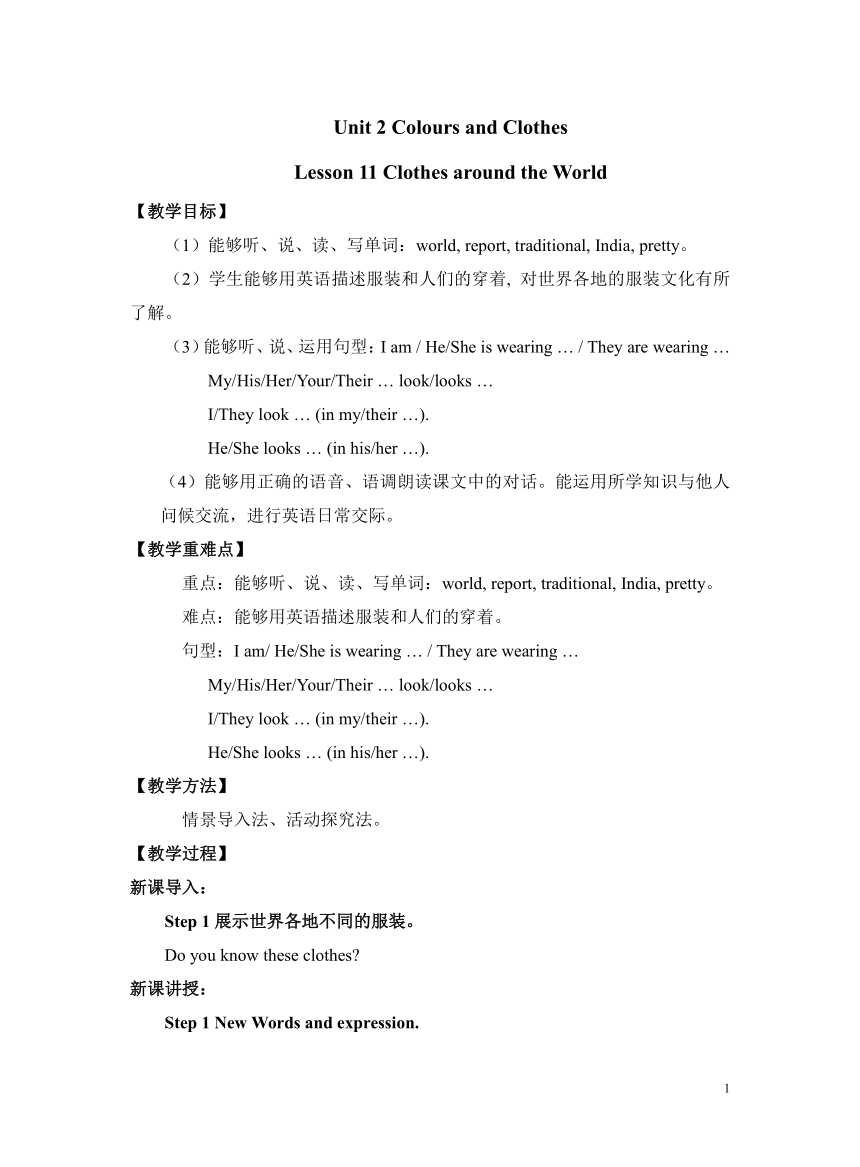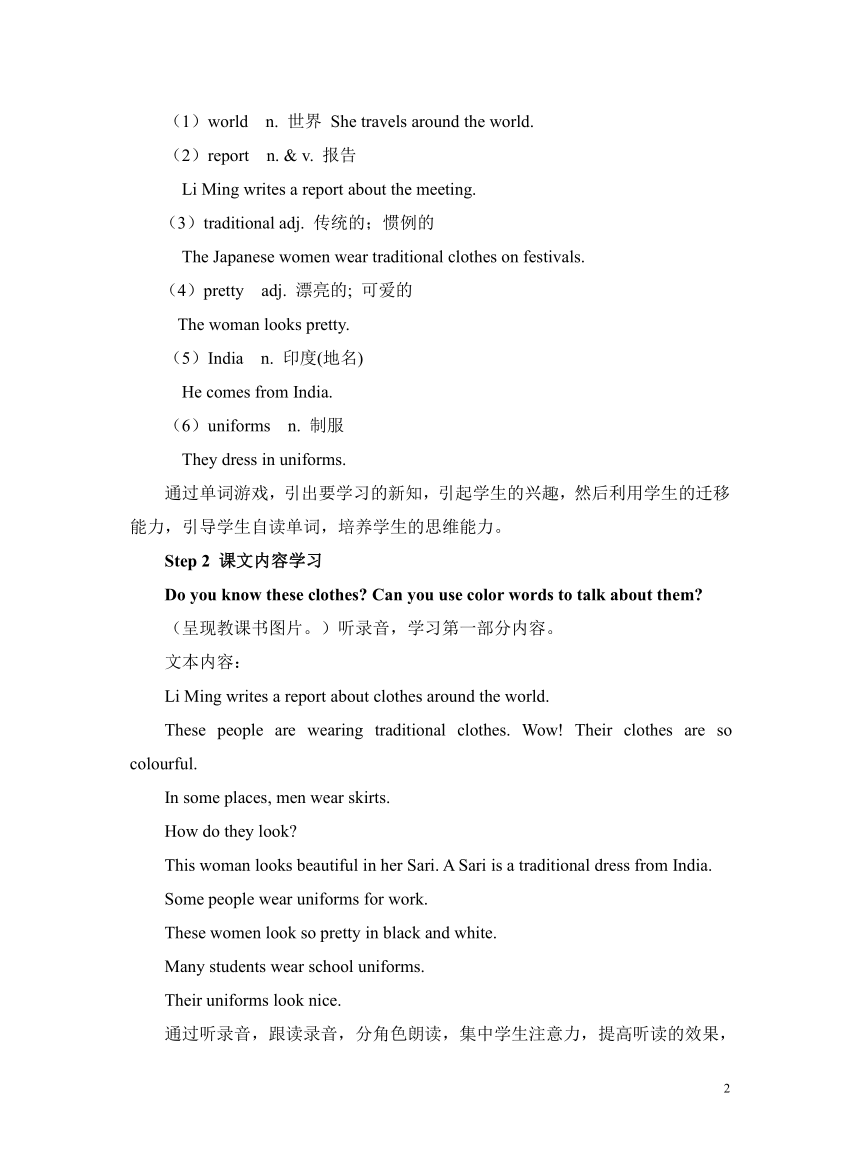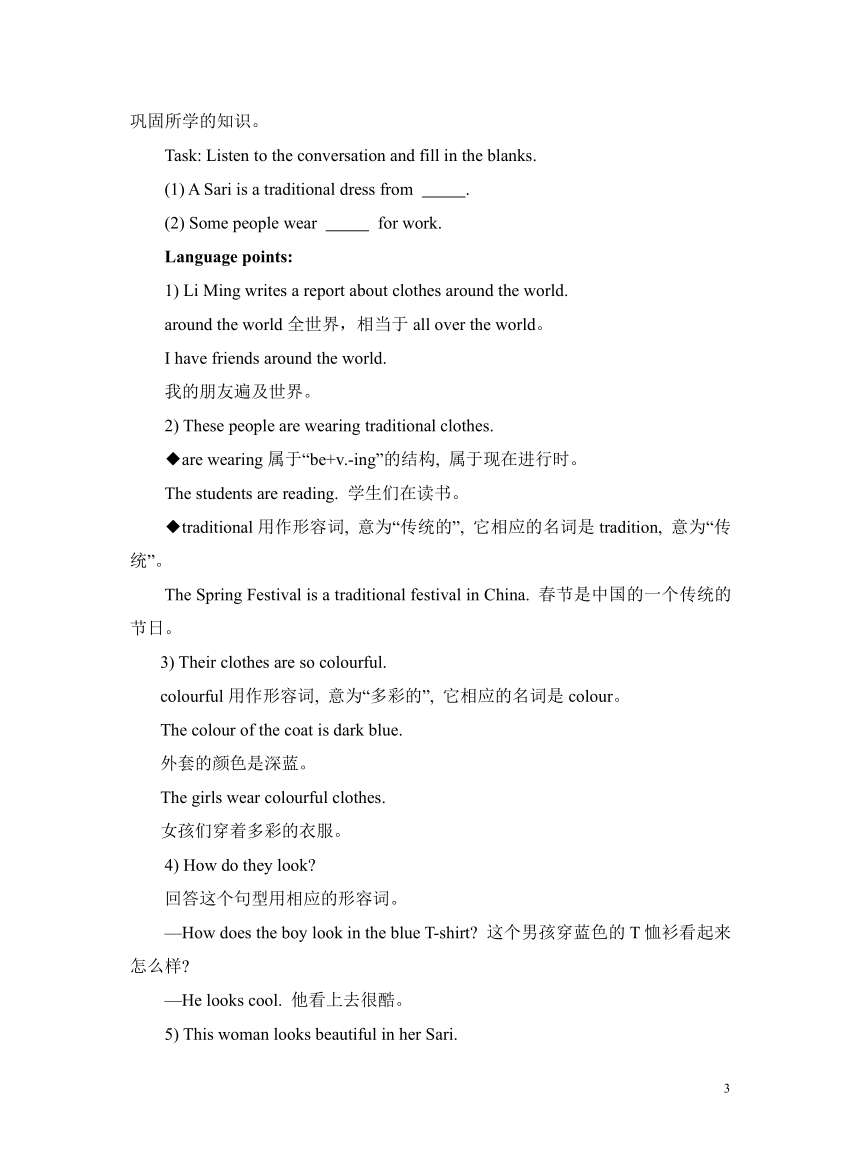冀教版英语七年级上册 Unit 2 Lesson 11 Clothes around the World 教案
文档属性
| 名称 | 冀教版英语七年级上册 Unit 2 Lesson 11 Clothes around the World 教案 |  | |
| 格式 | docx | ||
| 文件大小 | 19.4KB | ||
| 资源类型 | 教案 | ||
| 版本资源 | 冀教版 | ||
| 科目 | 英语 | ||
| 更新时间 | 2023-09-06 23:16:41 | ||
图片预览



文档简介
Unit 2 Colours and Clothes
Lesson 11 Clothes around the World
【教学目标】
(1)能够听、说、读、写单词:world, report, traditional, India, pretty。
(2)学生能够用英语描述服装和人们的穿着, 对世界各地的服装文化有所了解。
(3)能够听、说、运用句型:I am / He/She is wearing … / They are wearing …
My/His/Her/Your/Their … look/looks …
I/They look … (in my/their …).
He/She looks … (in his/her …).
(4)能够用正确的语音、语调朗读课文中的对话。能运用所学知识与他人问候交流,进行英语日常交际。
【教学重难点】
重点:能够听、说、读、写单词:world, report, traditional, India, pretty。
难点:能够用英语描述服装和人们的穿着。
句型:I am/ He/She is wearing … / They are wearing …
My/His/Her/Your/Their … look/looks …
I/They look … (in my/their …).
He/She looks … (in his/her …).
【教学方法】
情景导入法、活动探究法。
【教学过程】
新课导入:
Step 1展示世界各地不同的服装。
Do you know these clothes
新课讲授:
Step 1 New Words and expression.
(1)world n. 世界 She travels around the world.
(2)report n. & v. 报告
Li Ming writes a report about the meeting.
(3)traditional adj. 传统的;惯例的
The Japanese women wear traditional clothes on festivals.
(4)pretty adj. 漂亮的; 可爱的
The woman looks pretty.
(5)India n. 印度(地名)
He comes from India.
(6)uniforms n. 制服
They dress in uniforms.
通过单词游戏,引出要学习的新知,引起学生的兴趣,然后利用学生的迁移能力,引导学生自读单词,培养学生的思维能力。
Step 2 课文内容学习
Do you know these clothes Can you use color words to talk about them
(呈现教课书图片。)听录音,学习第一部分内容。
文本内容:
Li Ming writes a report about clothes around the world.
These people are wearing traditional clothes. Wow! Their clothes are so colourful.
In some places, men wear skirts.
How do they look
This woman looks beautiful in her Sari. A Sari is a traditional dress from India.
Some people wear uniforms for work.
These women look so pretty in black and white.
Many students wear school uniforms.
Their uniforms look nice.
通过听录音,跟读录音,分角色朗读,集中学生注意力,提高听读的效果,巩固所学的知识。
Task: Listen to the conversation and fill in the blanks.
(1) A Sari is a traditional dress from .
(2) Some people wear for work.
Language points:
1) Li Ming writes a report about clothes around the world.
around the world全世界,相当于all over the world。
I have friends around the world.
我的朋友遍及世界。
2) These people are wearing traditional clothes.
◆are wearing属于“be+v.-ing”的结构, 属于现在进行时。
The students are reading. 学生们在读书。
◆traditional用作形容词, 意为“传统的”, 它相应的名词是tradition, 意为“传统”。
The Spring Festival is a traditional festival in China. 春节是中国的一个传统的节日。
3) Their clothes are so colourful.
colourful用作形容词, 意为“多彩的”, 它相应的名词是colour。
The colour of the coat is dark blue.
外套的颜色是深蓝。
The girls wear colourful clothes.
女孩们穿着多彩的衣服。
4) How do they look
回答这个句型用相应的形容词。
—How does the boy look in the blue T-shirt 这个男孩穿蓝色的T恤衫看起来怎么样
—He looks cool. 他看上去很酷。
5) This woman looks beautiful in her Sari.
in“穿着”, 接衣服或颜色, 意为“穿着……衣服或……颜色的衣服”。
The woman in a red coat is my aunt.
穿红外套的女人是我的婶婶。
The boy in white is my brother.
穿白色衣服的男孩是我的弟弟。
6) What colours are they 它们是什么颜色的?
此句为what引导的特殊疑问句。句中的they指的是上文提到的uniforms。
e.g. What colours do you like 你喜欢什么颜色?
Step 3 Let’s Do It!
1. Discuss the questions.
2. Listen to the statements and number the pictures.
3. Read the passage and fill in the blanks.
4. People wear different traditional clothes all around the world. What are some traditional clothes people wear in China Collect some pictures and write about them.
Role play
1. Role play the conversation in groups;
2. Role play the conversation in front of the class.
课堂练习:
一、用方框中的单词或短语的正确形式填空
traditional India look so pretty in black and white what colours
1. Mary and Susan _____________ in purple dresses.
2. A Sari is a dress from ________.
3. This lady is wearing __________ Tibetan clothes.
4. ____________ are the school uniforms
5. These women look nice _________________.
二、单项选择
1. We like the books ________ animals.
A. into B. about C. in D. at
2. These flowers are very ________. I like them very much.
A. old B. beautiful C. well D. busy
3. We write a report about colours ________ the world.
A. at B. into C. around D. to
三、按要求完成下列各题
1. I have some dresses. (改为否定句)
I ________ ________ ________ dresses.
2. Look! This man wears a skirt. (改为复数句)
Look! ________ ________ wear ________.
3. Do the students wear beautiful clothes (作肯定回答)
________, ________ ________.
4. They wear uniforms for work. (对画线部分提问)
________ ________ they wear uniforms
5. Li Ming writes a report. (改为一般疑问句)
________ Li Ming ________ a report
课堂小结:
T: What did you learn about this lesson
学生自由说,教师总结。
语言知识:
1) 识记以下单词: world, report, traditional, India, pretty。
2) 掌握短语及句型:
I am/He/She is wearing … / They are wearing …
My/His/Her/Your/Their … look/looks …
I/They look … (in my/their …).
He/She looks … (in his/her …).
语言技能:
1)能运用所学知识与他人问候交流。
2)听懂并能进行英语日常交际。。
将本节课所学的知识进行归纳,帮助学生理解和记忆,巩固提升本课时所学的知识。
作业布置:
完成配套课后练习。
【板书设计】
Unit 2 Colours and Clothes
Lesson 11 Clothes around the World
单词:world, report, traditional, India, pretty
句型:I am/He/She is wearing … / They are wearing …
My/His/Her/Your/Their … look/looks …
I/They look … (in my/their …).
He/She looks … (in his/her …).
【课后反思】
本课时的教学内容是冀教版七年级上册英语第二单元的第五课时, 重点在于世界各地服饰文化, 从clothes around the world开始, 自然地导入全世界人们着装的话题。以生活实际为基础, 分别介绍了世界各地有特色的服装、制服和校服, 训练学生的听力和口语表达能力。利用动作、手势和图片学习英语单词, 同时在对话中反复运用新学的单词和短语。因此, 可以将知识目标定为掌握本课时新出现的词和短语, 怎么描述服装和穿着的句型。
1
Lesson 11 Clothes around the World
【教学目标】
(1)能够听、说、读、写单词:world, report, traditional, India, pretty。
(2)学生能够用英语描述服装和人们的穿着, 对世界各地的服装文化有所了解。
(3)能够听、说、运用句型:I am / He/She is wearing … / They are wearing …
My/His/Her/Your/Their … look/looks …
I/They look … (in my/their …).
He/She looks … (in his/her …).
(4)能够用正确的语音、语调朗读课文中的对话。能运用所学知识与他人问候交流,进行英语日常交际。
【教学重难点】
重点:能够听、说、读、写单词:world, report, traditional, India, pretty。
难点:能够用英语描述服装和人们的穿着。
句型:I am/ He/She is wearing … / They are wearing …
My/His/Her/Your/Their … look/looks …
I/They look … (in my/their …).
He/She looks … (in his/her …).
【教学方法】
情景导入法、活动探究法。
【教学过程】
新课导入:
Step 1展示世界各地不同的服装。
Do you know these clothes
新课讲授:
Step 1 New Words and expression.
(1)world n. 世界 She travels around the world.
(2)report n. & v. 报告
Li Ming writes a report about the meeting.
(3)traditional adj. 传统的;惯例的
The Japanese women wear traditional clothes on festivals.
(4)pretty adj. 漂亮的; 可爱的
The woman looks pretty.
(5)India n. 印度(地名)
He comes from India.
(6)uniforms n. 制服
They dress in uniforms.
通过单词游戏,引出要学习的新知,引起学生的兴趣,然后利用学生的迁移能力,引导学生自读单词,培养学生的思维能力。
Step 2 课文内容学习
Do you know these clothes Can you use color words to talk about them
(呈现教课书图片。)听录音,学习第一部分内容。
文本内容:
Li Ming writes a report about clothes around the world.
These people are wearing traditional clothes. Wow! Their clothes are so colourful.
In some places, men wear skirts.
How do they look
This woman looks beautiful in her Sari. A Sari is a traditional dress from India.
Some people wear uniforms for work.
These women look so pretty in black and white.
Many students wear school uniforms.
Their uniforms look nice.
通过听录音,跟读录音,分角色朗读,集中学生注意力,提高听读的效果,巩固所学的知识。
Task: Listen to the conversation and fill in the blanks.
(1) A Sari is a traditional dress from .
(2) Some people wear for work.
Language points:
1) Li Ming writes a report about clothes around the world.
around the world全世界,相当于all over the world。
I have friends around the world.
我的朋友遍及世界。
2) These people are wearing traditional clothes.
◆are wearing属于“be+v.-ing”的结构, 属于现在进行时。
The students are reading. 学生们在读书。
◆traditional用作形容词, 意为“传统的”, 它相应的名词是tradition, 意为“传统”。
The Spring Festival is a traditional festival in China. 春节是中国的一个传统的节日。
3) Their clothes are so colourful.
colourful用作形容词, 意为“多彩的”, 它相应的名词是colour。
The colour of the coat is dark blue.
外套的颜色是深蓝。
The girls wear colourful clothes.
女孩们穿着多彩的衣服。
4) How do they look
回答这个句型用相应的形容词。
—How does the boy look in the blue T-shirt 这个男孩穿蓝色的T恤衫看起来怎么样
—He looks cool. 他看上去很酷。
5) This woman looks beautiful in her Sari.
in“穿着”, 接衣服或颜色, 意为“穿着……衣服或……颜色的衣服”。
The woman in a red coat is my aunt.
穿红外套的女人是我的婶婶。
The boy in white is my brother.
穿白色衣服的男孩是我的弟弟。
6) What colours are they 它们是什么颜色的?
此句为what引导的特殊疑问句。句中的they指的是上文提到的uniforms。
e.g. What colours do you like 你喜欢什么颜色?
Step 3 Let’s Do It!
1. Discuss the questions.
2. Listen to the statements and number the pictures.
3. Read the passage and fill in the blanks.
4. People wear different traditional clothes all around the world. What are some traditional clothes people wear in China Collect some pictures and write about them.
Role play
1. Role play the conversation in groups;
2. Role play the conversation in front of the class.
课堂练习:
一、用方框中的单词或短语的正确形式填空
traditional India look so pretty in black and white what colours
1. Mary and Susan _____________ in purple dresses.
2. A Sari is a dress from ________.
3. This lady is wearing __________ Tibetan clothes.
4. ____________ are the school uniforms
5. These women look nice _________________.
二、单项选择
1. We like the books ________ animals.
A. into B. about C. in D. at
2. These flowers are very ________. I like them very much.
A. old B. beautiful C. well D. busy
3. We write a report about colours ________ the world.
A. at B. into C. around D. to
三、按要求完成下列各题
1. I have some dresses. (改为否定句)
I ________ ________ ________ dresses.
2. Look! This man wears a skirt. (改为复数句)
Look! ________ ________ wear ________.
3. Do the students wear beautiful clothes (作肯定回答)
________, ________ ________.
4. They wear uniforms for work. (对画线部分提问)
________ ________ they wear uniforms
5. Li Ming writes a report. (改为一般疑问句)
________ Li Ming ________ a report
课堂小结:
T: What did you learn about this lesson
学生自由说,教师总结。
语言知识:
1) 识记以下单词: world, report, traditional, India, pretty。
2) 掌握短语及句型:
I am/He/She is wearing … / They are wearing …
My/His/Her/Your/Their … look/looks …
I/They look … (in my/their …).
He/She looks … (in his/her …).
语言技能:
1)能运用所学知识与他人问候交流。
2)听懂并能进行英语日常交际。。
将本节课所学的知识进行归纳,帮助学生理解和记忆,巩固提升本课时所学的知识。
作业布置:
完成配套课后练习。
【板书设计】
Unit 2 Colours and Clothes
Lesson 11 Clothes around the World
单词:world, report, traditional, India, pretty
句型:I am/He/She is wearing … / They are wearing …
My/His/Her/Your/Their … look/looks …
I/They look … (in my/their …).
He/She looks … (in his/her …).
【课后反思】
本课时的教学内容是冀教版七年级上册英语第二单元的第五课时, 重点在于世界各地服饰文化, 从clothes around the world开始, 自然地导入全世界人们着装的话题。以生活实际为基础, 分别介绍了世界各地有特色的服装、制服和校服, 训练学生的听力和口语表达能力。利用动作、手势和图片学习英语单词, 同时在对话中反复运用新学的单词和短语。因此, 可以将知识目标定为掌握本课时新出现的词和短语, 怎么描述服装和穿着的句型。
1
同课章节目录
- Unit 1 School and friends
- Lesson 1 Hello!
- Lesson 2 Teacher and Students
- Lesson 3 Welcome to Our School
- Lesson 4 What Is It?
- Lesson 5 May I Have a Book?
- Lesson 6 Things for School
- Unit 2 Colours and Clothes
- Lesson 7 Jenny's New Skirt
- Lesson 8 Danny's Favourit Colou
- Lesson 9 Whose Coat Is This?
- Lesson 10 Clothes for a Cold Day
- Lesson 11 Clothes around the World
- Lesson 12 Let's Go Shopping!
- Unit 3 Body Parts and Feelings
- Lesson 13 Body Parts
- Lesson 14 Colours and Feelings
- Lesson 15 Tall or Short
- Lesson 16 Happy or Sad
- Lesson 17 Seeing a Docto
- Lesson 18 We All Look Different!
- Unit 4 Food and Restaurants
- Lesson 19 Time for Breakfast!
- Lesson 20 I Like the Supermarket!
- Lesson 21 At the Market
- Lesson 22 In the Restaurant
- Lesson 23 The Corner Store
- Lesson 24 Eat Good Food!
- Unit 5 Family and Home
- Lesson 25 Jenny's Family
- Lesson 26 Li Ming's Family
- Lesson 27 Danny at Home
- Lesson 28 A Family Picnic
- Lesson 29 A Birthday Card
- Lesson 30 Grandma's Birthday Party
- Unit 6 Let's Go!
- Lesson 31 Let's Go to the Bookstore!
- Lesson 32 At the Supermarket
- Lesson 33 Let's Go to the Zoo!
- Lesson 34 On the Farm
- Lesson 35 Let's Go to the Museum!
- Lesson 36 Let's Go to the Movie Theatre!
- Unit 7 Days and Months
- Lesson 37 Seasons and Weathe
- Lesson 38 Nick's Busy Month
- Lesson 39 A Class Calenda
- Lesson 40 When Is Your Birthday?
- Lesson 41 Holidays
- Lesson 42 Happy Holidays!
- Unit 8 Countries around the world
- Lesson 43 Directions
- Lesson 44 Jack's Goodbye Party
- Lesson 45 China
- Lesson 46 Canada and the U.S.
- Lesson 47 The U.K. and Australia
- Lesson 48 English-Speaking Countries
